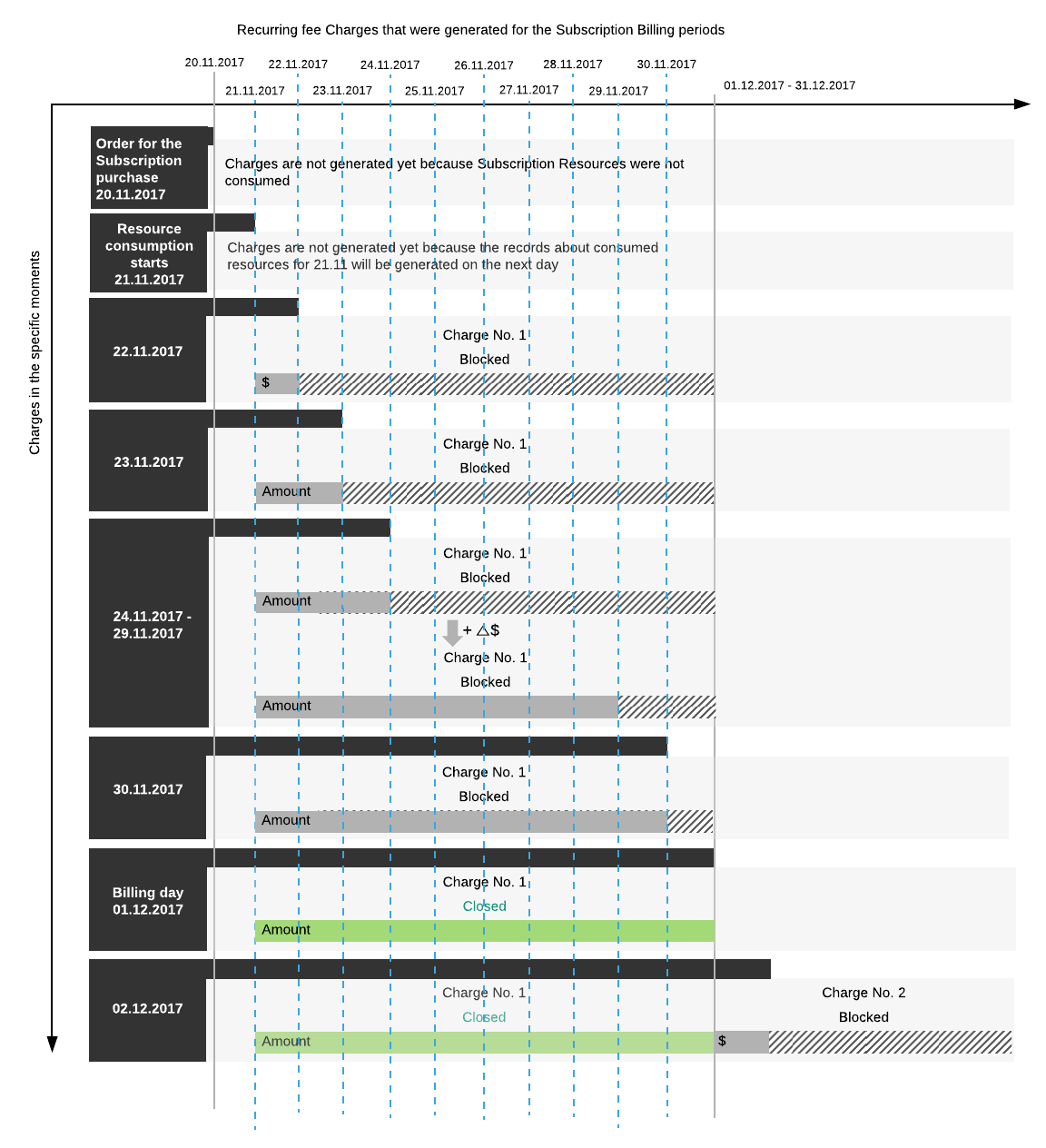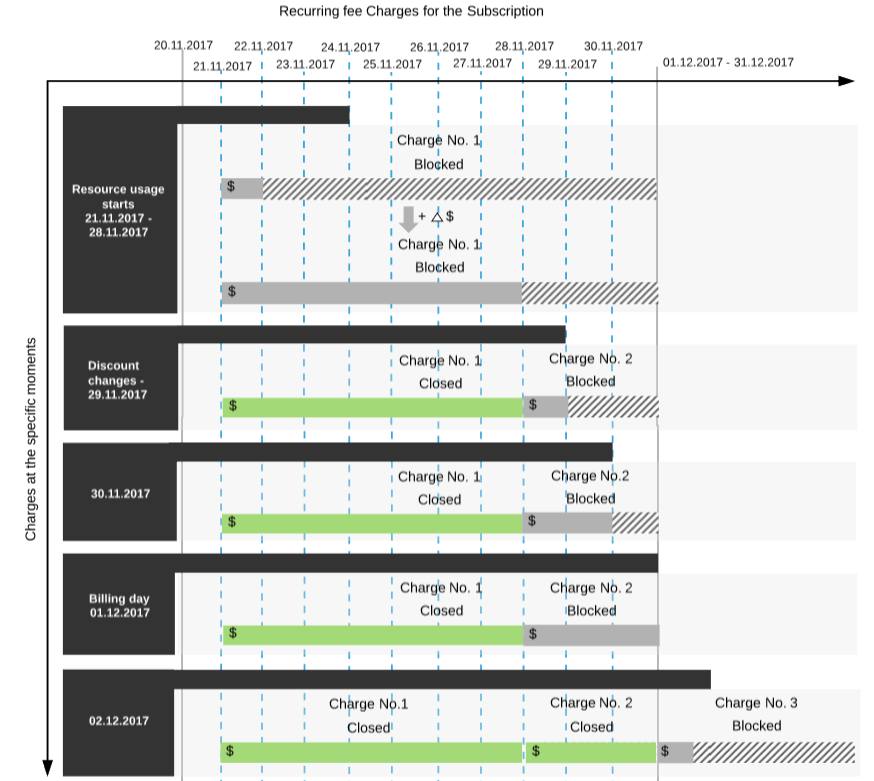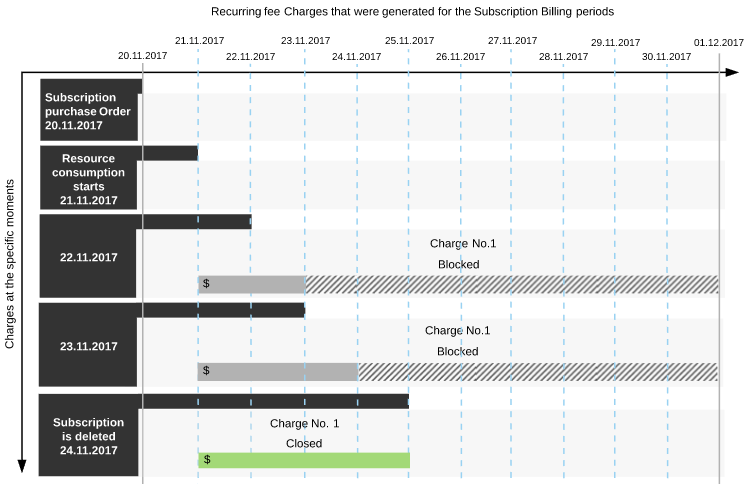Pay as you go. Charges generation
For particular aspects of Charges generation for the Postpay model, see Particular aspects of Charges within the Postpay charging model.
In this article:
Charges types that are generated for the Subscriptions with the Pay as you go billing type
The Pay as you go billing type divides into two subtypes:
- Pay as you go (external).
- Pay as you go (internal).
These subtypes differ by the method of Resources net costs storing, and by the types of Charges that are generated for the Resources usage.
The following types of Charges are generated for the Subscriptions with the Pay as you go billing type:
- Recurring fee for the Pay as you go (internal) billing type.
- Subscription resource consumption for the Pay as you go (external) billing type.
However, the Charges behavior is the same for both types. The difference between these types of Charges is in the sources of consumed Resources net costs:
- Resources net costs in case of the Pay as you go (internal) billing type are stored in the platform and are specified during the Plan creation (see Plan Resources).
- Resources net costs in case of the Pay as you go (external) billing type are stored at the Service provider side and are requested via API to create the consumed resources records.
Within this article, both types of Charges are regarded together without distinguishing their types.
Particular aspects of Charges for Pay as you go billing type
The Pay as you go billing type supposes that a user pays only for the actual consumption of the Subscription Resources. Payments for the previous month are completed at the set Billing day. It is possible for a user to pay with the negative Account balance within the set Financial blocking threshold, as well as to pay using the Guaranteed payment (see Creating an Account Class).
In the majority of cases, the setup, renewal and transfer fees for the Application and Resources and the recurring fee for the Application for the Subscriptions with the Pay as you go billing type are set equal to zero.
The Charge amount calculating and changing is based on the consumed resources records (see Charges attributes).
Statistics and details on the Resources usage is available when viewing the consumed resources records (see Viewing the List of consumed resources for Subscriptions with the Pay as you go billing type).
The mechanism and periodicity of consumed resources records generation differ for Services depending on the plugin, on which the Application template is based (see ActivePlatform. Services. Operator documentation).
General rules for Pay as you go billing type
Generation and changing of attributes of the Recurring fee Charges for the Pay as you go billing type have the following specific aspects:
When the discount, resources costs or the automatic markup rate are changed during the Billing period, several Charges are created for one period. The first Charge is generated according to the rules described in this paragraph. The next Charges are generated at the moment of the discount, resources costs or the automatic markup rate changing. At the same moment, the first Charge, which is blocked, receives the Closed status.
The details about Charges behavior in case of the discount, resources costs or the automatic markup rate changing during the Billing period are given below.
- Only one Charge is generated for each Billing period.
- Charge period starts from the date of the beginning of the Resource usage for the first Charge, or from the Billing day for the following Charges, and ends at the next Billing day.
- The Charge has the Blocked status.
- The Charge amount is changed with a periodicity set in the Service settings, proportionally to the amount of the consumed Resources.
- The date of the Charge creation depends on the periodicity of the Resources consumption data update. The Charge is created after the processing of the first records about consumed resources.
- The Charge close date is the nearest Billing day.
Subscription Order and Resources consumption
An example of the Charges for the Subscription, consumed resources records for which are generated once a day, is given below.
Let's assume that the Billing day is set as a 1st day of each month.
- The Subscription is ordered on 20.11.2017, but the Resources are yet unused. The Charges are not generated yet, because no Resources were consumed.
- The Resources usage starts 21.11.2017. The Charges are not generated yet, because consumed resources records are generated only once per day for the previous day.
- On the 22.11.2017, the first consumed resources records are generated, and the Charge No.1 is created on their basis with the following attributes:
- The Charge amount is proportional to the periodicity of the consumed resources records creation (24 hours in the example) and to the amount of consumed Resources per this period. The corresponding amount is blocked on the Account balance.
- Charge period: from the date when the Resources usage starts to the end date of the corresponding Billing period.
- Created at: Charge generation (consumed resources records creation) date.
- Close date: corresponding Billing period end date.
- Status: Blocked.
- Each next 24 hours (in general case, each time the new consumed resources records were created) up to the end of the corresponding Billing period:
- The Charge amount changes increasing by the value, that is calculated by the following formula:
Δ = (Price of the one unit of Resource per month) х (Periodicity of consumed resources records generation, in days) х (Amount of consumed Resource units) / 30 days,
where Δ — amount of Charge increment. - The amount increment is blocked on the Account balance.
- The Charge amount changes increasing by the value, that is calculated by the following formula:
- At the nearest Billing day (01.12.2017 in the example), the Charge No. 1 is closed, and the corresponding amount is charged off from the Account balance.
- On 02.12.2017, new consumed resources records in the next Billing period are created, and the Charge No. 2 is generated on their basis. Generation and changing of attributes of the Charge No. 2 is similar to the generation and changing of attributes of the Charge No. 1.
The same operations are repeated each next Billing period.
Charges behavior when the Resources costs change during the Billing period
For the Pay as you go (internal) billing type
Resources costs change when one or several following parameters are changed:
Changes at the levels of all Resellers are taken into account, even when some of them disabled automatic markup.
- An automatic markup for the Plan (see Changing the automatic markup for existing Plans).
- For the Pay as you go (internal) billing type — a net cost of the Plan (see Viewing the Price List).f
- A discount that is applicable to the Charge (see Managing Discounts).
When the Resources costs change during the Billing period, the following occurs:
- The Charge for the period, in which the old cost was applicable, receives the Closed status. The accumulated amount is charged off from the Account balance.
- A new Charge is created with the following attributes:
- Status: Blocked.
- Period start date: a date, when the cost changed.
- Period end date: last day of the current Billing period.
- A new Charge is incremented progressively based on the consumed resources records.
- On the Billing day after the end of the Billing period, the second Charge receives the Closed status. The accumulated amount is debited from the Account balance.
For the Pay as you go (external) billing type
Resources costs change when one or several following parameters are changed:
Changes at the levels of all Resellers are taken into account, even when some of them disabled automatic markup.
- An automatic markup for the Plan (see Changing the automatic markup for existing Plans).
- A discount that is applicable to the Charge (see Managing Discounts).
When an automatic markup for the Plan is changed during a Billing period, the following changes are applied:
- For Subscriptions ordered at the Plan prices (see Ordering a Subscription at the Plan prices) without the fixed price, any changes of the automatic markup in the Price list section at any level cause the following changes in the Subscriptions to the Plan:
- The customer Charge for the current Billing period remains in the Blocked status.
- When new consumption statistics are received, a new customer Charge is created. This Charge uses the new price chain with the updated automatic markups of the Plan at all levels.
- All new statistics are included in this new Charge. The Charge uses the updated automatic markup taking into account the automatic markups at other levels.
- For Subscriptions ordered at the individual markup (see Ordering a Subscription at the individual markup) without the fixed price, any changes of the automatic markup in the Price list section at any upstream level or on the Price list tab of the Subscription ordered at the individual markup cause the following changes in the Subscriptions to the Plan:
- The customer Charge for the current Billing period remains in the Blocked status.
- When new consumption statistics are received, a new customer Charge is created. This Charge uses the new price chain with the updated automatic markups of the Plan at the upstream levels and the current value of the individual markup.
- All new statistics are included in this new Charge. The Charge uses the updated automatic markup at the upstream levels and the current value of the individual markup.
- For Subscriptions without the fixed price, reseller Charges use their automatic markup chains that were applied to the corresponding closed customer Charges.
- For Subscriptions with the fixed price, when the automatic markup for the Plan is changed in the Price list section at any upstream level, reseller Charges use the automatic markups at upstream levels that were set at the moment of ordering the Subscription.
For discount changes, behavior is similar to the Pay as you go (internal) billing type.
Subscription deleting
When the Subscription is deleted, the Charge for the current Billing period changes its period and close date, and receives the Closed status. The accumulated amount is charged off from the Account balance.




